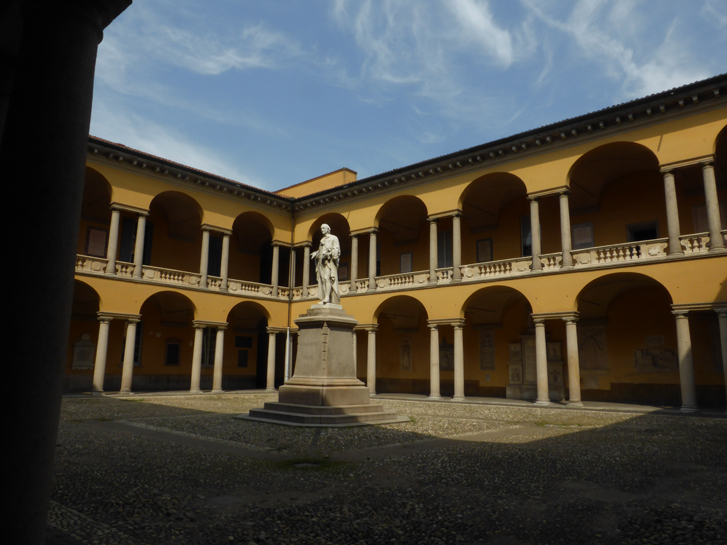
Description
In the heart of Lombardy lies one of the oldest and most significant universities in Europe, giving Pavia a glowing and prestige touch. The illustrious Institution now home to libraries, archives and museums that bear witness to the intense activity of culture, research and dissemination of knowledge took place over the centuries and is still ongoing.
Emperor Lothair of Lombard founded the University of Pavia, the oldest in Italy and one of the most significant in Europe in 825 AD. The University was originally established in 1361 as a Studium Generale in the reign of Emperor Charles IV, but was later remodeled and commanded by Galeazzo Visconti II, Duke of Milan. Visconti promoted the opening by activating the studies of Law, Medicine, Philosophy and Literature thus attracting students from all over Europe. A notable expansion in the middle Ages and one still existing in the eleventh century is found in the Law School. The School of Law was an important faculty commissioned by Emperor Theodosius I. It included the teachings of law for the formation of notaries and judges palatine.
In the beginning the university was not seen as that of an important one, however it was in the late fourteenth century that its fame was increasing. It acquired its great reputation through the teachings of prominent jurists and this prestigious university was growing even more which was seen in the increasing numbers of students. Many international renowned professors held courses at the university. Among these was Lorenzo Valla known for his studies in philosophy and literature.
The seventeenth century saw the rebirth of the University of Pavia due to the Spanish domination through the liberal policy of the Austrian rulers, Maria Theresa and Joseph II. Introduced is an impressive program, strengthening the teaching, research and rehabilitation of the building. The Institute saw some of the most famous teachers of international status. Among these were Lazzaro Spallanzani, Professor of Natural Sciences, Lorenzo Mascheroni, Professor of Mathematics, Alessandro Volta, Professor of Experimental Physics and creator of the electric battery, and the Rector of the University Antonio Scarpa, Professor of Anatomy. The Napoleonic era also saw the presence of the teachers of Eloquence, Vincenzo Monti and Ugo Foscolo.
During the nineteenth century, the medical school and the school of mathematics of Pavia introduced great personalities. These individuals gave a new and powerful boost to scientific research with important consequences on a national and international level. Several notable longstanding mathematicians in Pavia were Eugenio Beltrami, Felice Casorati and Luigi Berzolari. In 1906 professor of histology and general pathology, Camillo Golgi received the Nobel Prize, for his studies on the structure of the nervous system, while Carlo Forlanini was the inventor of pneumothorax for the treatment of pulmonary tuberculosis who devised new methods of treatment. As well as Golgi, two other professors of the University of Pavia were awarded with a Nobel Prize: Chemist Giulio Natta and Physicist Carlo Rubbia.
In the twentieth century, the activities of the University of Pavia grew in every field. The legal disciplines had a prominent position. Pasquale Del Giudice and Arrigo Solmi in Legal History; Contardo Ferrini and Peter Bonfante in Roman law; Luigi Cossa and Giussepe Griziotti in Economics. The end of World War II saw a new revival in the University of Pavia due to a large part of the energy and initiative of the rector Plinio Fraccaro.
Since the mid-sixteenth century Pavia was equipped with two large University Colleges: Ghislieri and Borromeo. In the nineteenth century they played an important role in the preparation of most of the cultural and intellectual elite in Lombardia and Italy. In 1945 due to the plan of expansion of the university facilities, the creation of the new colleges was seen as the best way to facilitate the access of deserving young people. This is a culture that is no longer used, as it is socially open to most without losing its credibility.
Today, the university offers its services in three locations: Pavia, Cremona and Mantua. Its diverse nature boasts a wide variety of courses; including graduate and doctoral level programs, participation in international projects, work alongside many major colleges around the world and promote interdisciplinary research. The University of Pavia has acquired an impressive collection of cultural artifacts over its long history. Particularly the historical and scientific collections, which are unique in their kind: they are in fact made up of pieces acquired randomly, but increased over time, in parallel with the development of teaching and scientific research in their respective fields.
Insights
| Itineraries |
|---|
| Pavia: art, culture and tradition |
| Where to sleep |
|---|
| Where to eat |
|---|







